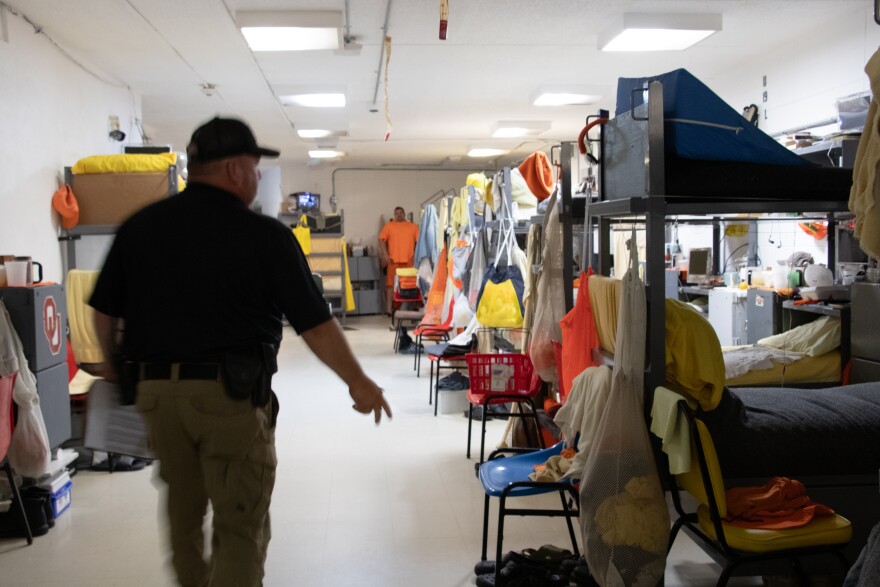The John H. Lilley Correctional Center doesn't scream high-tech.
The men's minimum-security prison, built in 1925 as the Oklahoma State School for Incorrigible Negro Boys and repurposed in the early 1980s to accommodate adult offenders, sits among soft rolling hills and cattle farms. One-third of its 825 prisoners is elderly or medically frail, with many requiring wheelchairs or walkers to get from their dormitory-style bunk beds to the chow hall.
It's one of 23 state prisons that Department of Corrections Executive Director Steven Harpe envisions as the next frontier for artificial intelligence.
"We've got facility needs. We have a lot of old buildings," Harpe said in an interview. "But right now, we are undergoing a transformation that we're going to invest money on."
The revolution Harpe envisions includes drones sweeping the perimeter of prison yards for contraband, artificial intelligence programs to monitor phone calls and other technology he said will eliminate "administrative mundane work" from staff responsibilities.
Harpe said he sees artificial intelligence as the future, with Oklahoma uniquely positioned to incorporate it into public safety initiatives. Critics question the reliability of the technology and say the effort could shift focus from other agency goals like boosting staff recruitment.

Gov. Kevin Stitt appointed Harpe to lead Oklahoma's prison system in October 2022. Before entering state service as the director of the Office of Management and Enterprise Services in 2019, Harpe's previous professional experience was in the technology sector, with stints at companies like CGI, Capital One, HireRight and HP. He traveled to Washington, D.C. in July to congressional briefing on behalf of the American Correctional Association and said his background has made him the "go-to guy for all things AI."
Efforts to incorporate AI into state prisons have already begun. Correctional officers statewide began wearing body cameras in October. In March, the Department of Corrections signed a one-year, $1.07 million contract with Texas-based Leo Technologies, LLC, to automatically transcribe phone conversations in near real-time and alert staff to security risks.
John H. Lilley is one of seven facilities selected to incorporate the Verus system, which has been implemented at a handful of state prisons and county jails nationwide. Staff can select certain keywords for flagging, such as "kill" or "snitch." Developers say the technology is unbiased, with staff unable to filter results based on race, ethnicity, religion or sexual preference.
Perhaps the most aspirational technology would utilize strategically placed cameras to automatically conduct prisoner counts. Harpe believes that the camera system could eventually be used to gather other data, such as gang affiliation, and even identify prisoners experiencing mental health issues.
"What if I was able to take that labor [for prisoner counts] and instead of using people to do it, I was using facial recognition AI, not just one time, but use it all the time," Harpe said during a July 11 Congressional briefing on AI in public safety. "I always know where they are. You get logistics of who's talking to who. Technology now exists where you can look at a body in real-time and tell if you're carrying something, if you have something stowed somewhere on you. It also lets us do really cool things like suicide prevention."

Bryan Duke, a sergeant at John Lilley, has concerns about using AI to conduct counts. He walks through the dorm-style rooms of the prison with a list of names clipped to a wooden clipboard and pen in his hands.
"You're going to run into problems there," he said. "I'm not computer smart anyway, but I'd rather do a paper count. When you do a paper count, you're physically counting everybody that's here."
Duke said a count will usually take 15 to 20 minutes, depending on the officer. The day shift has three counts, at 10 a.m., 2 p.m. and 6 p.m. The night shift counts prisoners once per hour after lights out.
Privacy risks, cost scrutinized
Staff and prisoners alike laud the correctional officer body cameras as an effective accountability tool. The technology hasn't caught on as quickly in corrections as policing, as prisons and jails are equipped with closed-circuit camera systems, but proponents argue the devices help fill in blind spots and provide audio of encounters.
"It's like an eye in the sky," John H. Lilley prisoner Cortez Elston said. He said he appreciates that the cameras are always rolling, regardless of if the officer manually activates the device.
But some experts are skeptical of the agency's full-sprint push to implement other technology, including an Oklahoma prison staff advocate, a researcher and a state lawmaker.
Bobby Cleveland, a former state representative and executive director of the Oklahoma Corrections Professionals group, said he doesn't doubt that drones and more cameras could assist prison staff. But he said the technology won't alleviate a prison staffing shortage that's been linked to violence at multiple facilities.
"Who's going to look at those cameras," Cleveland said. "It can't do it all on its own."
Oklahoma's correctional staffing levels dropped 7.6% from June 2021 to June 2025, according to budget documents presented to the Board of Corrections. The Department of Corrections reports having funding to fill nearly 300 vacant correctional officer positions.
"I just think it's a way for him to talk about all these good things he can get, when he can't even handle what he's got," Cleveland said.
Beryl Lipton is a senior investigative researcher at the Electronic Frontier Foundation, a San Francisco-based digital rights group. She said the organization is concerned AI technology would create a biometric profile of an individual in order to count or track them, which could follow them after release. There have also been issues with AI call monitoring in places like Alabama, where the technology was programmed to alert staff to words like "abogado" and "abogada," Spanish for attorney.
"Sometimes people speak in another language. They have an accent. These are things that are likely not going to be easily captured by a transcription service," Lipton said. "And we worry about what inaccurate transcriptions can mean for people's due process."
Rep. Tom Gann, R-Inola, has been the Legislature's most vocal critic of automated license plate readers. He said he fears technology tested behind prison walls could be deployed into public settings.
"Whatever capability is exercised within the prison walls can be applied outside," he said. "That's the issue there. The technology is so pervasive."
Harpe acknowledged the importance of mitigating bias and pairing the technology with human expertise. He said his department thoroughly vets all the vendors it contracts with.
"I don't care if it's proprietary or not," he said. "We can sign NDAs, but we get in-depth on every solution that we utilize to make sure that it's going to meet, I guess, the expectations of Oklahomans."
Evolving regulations
The technology Lieutenant Jeffrey Hawman said would be most useful for his staff in Boley has been around since the 1990s but is outlawed under federal law.
"The only reason to use a cell phone is to conduct illicit activities," Hawman said, adding that cell phone jammers top his technology wish list. Hawman said cell phones get into the facility from visitors, people throwing bags over the razor-wire prison walls and leaving packages at a nearby farm where some prisoners work.
Federal regulators have long banned cell phone jammers, including in prisons and jails, because of their potential to interfere with legitimate communications like 911 calls, but that could change. A coalition of 31 state attorney generals, including Oklahoma Attorney General Gentner Drummond, is pushing Congress to pass legislation that would allow cell phone jammers in housing areas of prisons and jails. Measures were introduced in the U.S. House and Senate in March but haven't received a vote in either chamber.
"The proliferation of illegal cell phones in our prison systems represents a serious public safety threat to Oklahomans," Drummond said in a Mar. 26 statement. "These devices are not just communication tools for inmates, but dangerous instruments that enable criminal activities that extend far beyond prison walls and directly impact our communities."

Federal rule changes will also be required to allow all of the anti-drone technology Harpe wants to use. Current regulations authorize prison and jail officials to deploy passive drone-detection devices, but they can't shoot down or interfere with a device in flight. Prison staff flying drones over facilities must comply with a lengthy list of FAA rules.
The stakes of not expanding counter-drone technology in state prisons are high, Harpe said, referencing a June 2024 incident in a Georgia state prison where a prisoner killed a kitchen employee with a smuggled gun. Investigators suspect the gun was dropped into the facility via drone.

"There are a lot of real world things going on now that have forced our hand to be involved," he said.
As technology advances, Lipton said state and federal lawmakers and regulators will have to balance perceived security threats with protecting individual privacy. She said the data collected behind bars could outlive a person's prison sentence if sufficient safeguards aren't implemented.
"Creating a biometric profile of individuals, whether or not they're in prison, is incredibly invasive," she said. "If people are implementing those types of technologies in prison, there has to be a very clear policy and a real guarantee this information is not going anywhere."
Gann, the state lawmaker from Inola, said he fears the technology could skirt constitutional protections and unduly implicate people. But the quick rate of technological advancement and agency adoption can make developing AI regulation difficult.
"Legislatively, it's no man's land," he said. "There's not anything out here guiding law enforcement in what they can do, and the restriction that's out there is being totally ignored. We just need to get it all out in the open and work through this."
Still, Harpe warned against too much regulation from federal or state officials. He said bad actors will have access to advanced technology either way, and his department needs to be able to respond.
"We tend to get afraid of these things, and then we pull levers too far back," he said. "And then the tools that could be useful are no longer available."
This story was the result of a collaboration between Oklahoma Watch and public radio station KOSU.











